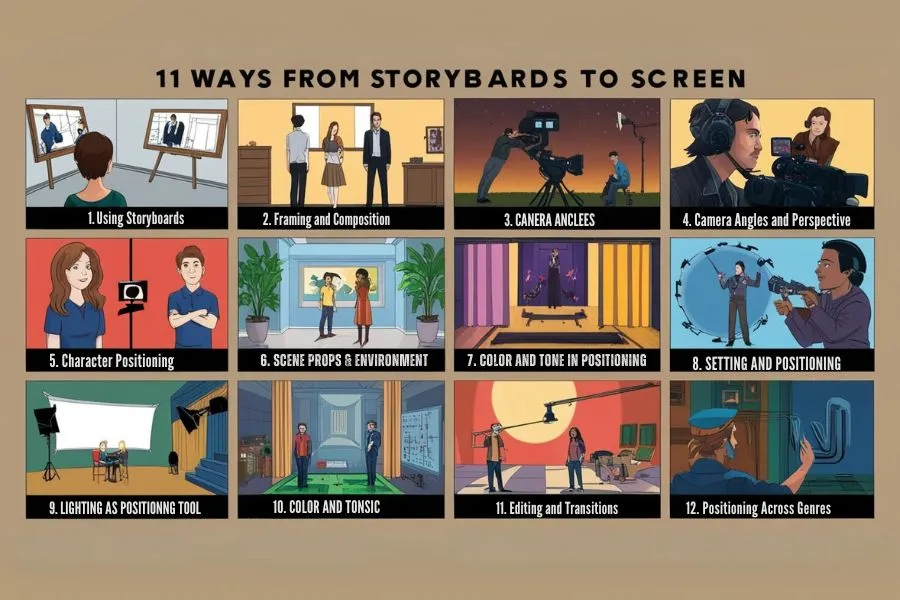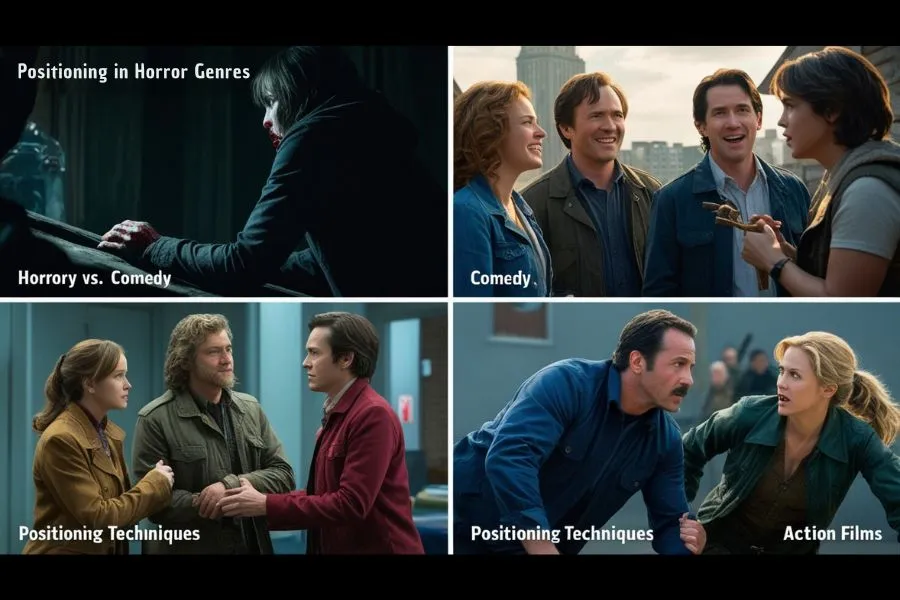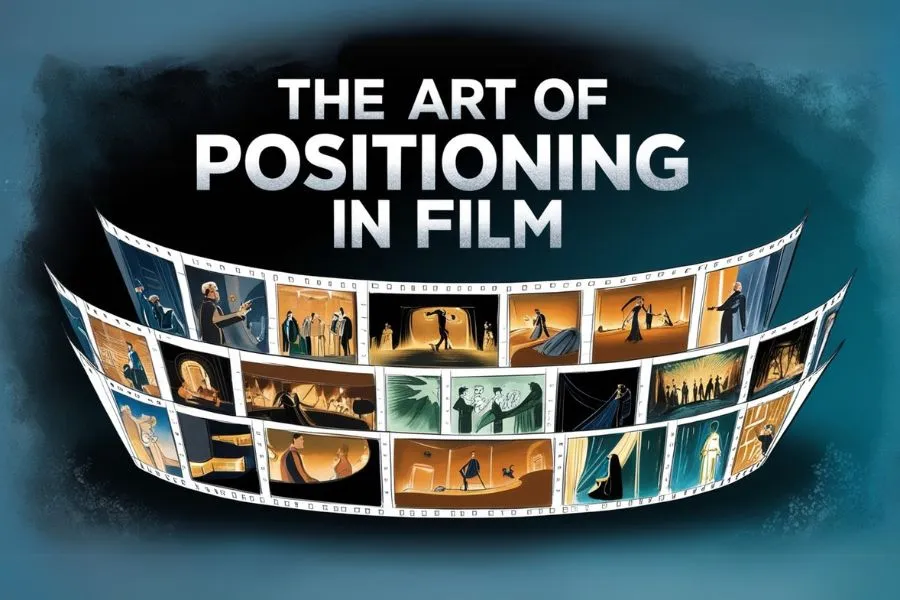Table of Contents
Introduction
The Art of Positioning in Film refers to the meticulous placement of characters, objects, and environments within the frame to enhance storytelling. This art is not only about where the actors stand but also about how they interact with the setting, props, and the camera itself. When executed skillfully, positioning conveys relationships, emotions, and underlying themes, bridging the gap between the director’s vision and the audience’s experience.
The Importance of Positioning in Storytelling
Positioning is crucial because it dictates how the audience perceives the story. Whether it’s highlighting a tense interaction or adding a comedic touch, The Art of Positioning in Film directs the viewer’s eye and sets the tone. In films like Inception and Birdman, the precision of positioning is integral to portraying complex ideas and evoking powerful emotions.
11 Ways From Storyboards to Screen!

1. Using Storyboards for Positioning
Creating the Blueprint: Visual Storytelling
Storyboards are the visual blueprint in The Art of Positioning in Film, guiding every detail of character and prop placement. Each frame in a storyboard serves as a mini-narrative, illustrating character positions, camera angles, and interactions that contribute to the overall story dynamics.
Collaborating with the Production Team
Through storyboards, directors collaborate closely with the production team to ensure positioning is practical and aligns with the creative vision. Storyboards play a fundamental role in planning, providing a roadmap for everyone involved in bringing The Art of Positioning in Film to life.
2. Framing and Composition
Rule of Thirds: Creating Visual Harmony
The rule of thirds divides the frame into a grid, encouraging filmmakers to place subjects along these lines or intersections. This classic technique in The Art of Positioning in Film enhances the composition’s balance, directing the audience’s focus to the most important elements in a scene.
The Power of Symmetry and Asymmetry
Symmetrical framing provides order, while asymmetrical positioning can add tension and unease. Directors like Wes Anderson excel at using symmetry, creating a structure that complements the narrative’s tone and style.
3. Camera Angles and Perspective
Close-Ups: Enhancing Emotional Impact
Close-ups are a staple in The Art of Positioning in Film, capturing detailed emotions and connecting the audience to a character’s inner world. This technique allows filmmakers to use positioning as a way to intensify emotional moments.
Wide Shots: Setting the Scene
Wide shots position characters within a larger environment, establishing context and giving audiences a broader understanding of the setting. In epics like Lawrence of Arabia, the wide shot serves as a powerful tool to convey scale and immerse viewers in the scene.
4. Character Positioning and Blocking
Defining Relationships through Spatial Placement
Blocking is a technique within The Art of Positioning in Film that defines relationships by placing characters in meaningful spatial relationships. For instance, distance between characters might indicate tension, while closeness may suggest intimacy or connection.
Using Blocking for Dramatic Effect
Filmmakers like Alfred Hitchcock employ blocking to build suspense, guiding the viewer’s attention and creating anticipation. Adjusting a character’s movement and positioning can influence the scene’s mood, elevating the dramatic effect.
5. Setting the Scene with Props and Environment
Incorporating Props for Narrative Depth
Props are crucial tools in The Art of Positioning in Film, often holding symbolic meaning or foreshadowing plot developments. In Citizen Kane, the snow globe serves as a vital prop that hints at the character’s backstory and emotional struggles.
Positioning in Environmental Storytelling
Stanley Kubrick’s The Shining demonstrates how The Art of Positioning in Film extends to environments. The Overlook Hotel itself becomes a character, with its layout and space amplifying the story’s tension and psychological horror.
6. Lighting as a Positioning Tool
Using Light and Shadow to Guide Attention
Lighting is another essential element in The Art of Positioning in Film, as it highlights specific areas, guiding the audience’s focus. In film noir, high-contrast lighting creates shadows that emphasize the mystery or danger surrounding a character.
Dramatic Lighting in Film Noir
In classic noir films, lighting not only shapes character dynamics but also adds visual tension, symbolizing the characters’ hidden motives and moral conflicts. This is a key aspect of The Art of Positioning in Film within this genre.
7. Color and Tone in Positioning
Color Palette Selection
The choice of color palette in The Art of Positioning in Film can significantly impact the tone and atmosphere. For instance, warm colors contribute to a cozy, nostalgic feel, while cool tones evoke a sense of unease or detachment.
Creating Mood with Tones
Directors use specific tones to evoke emotions aligned with the film’s genre. Horror films often employ muted, dark colors to create suspense, while vibrant colors in comedies add to the lightheartedness of the scenes.
8. Sound and Music in Positioning
Directing Emotional Response
Soundscapes are vital in The Art of Positioning in Film, guiding emotional responses. The use of high-energy music in action scenes builds excitement, while silence can add tension in a suspenseful scene.
Using Silence as Positioning
In A Quiet Place, silence is a critical component of The Art of Positioning in Film, intensifying the suspense as characters navigate a world where sound attracts danger.
9. Special Effects and Positioning
CGI in Enhancing Spatial Awareness
CGI can transform a scene, allowing creative positioning and perspective that wouldn’t be possible otherwise. In Avatar, CGI brings the world of Pandora to life, immersing viewers in an otherworldly landscape that enhances The Art of Positioning in Film.
Practical Effects for Realism
Practical effects are valuable in The Art of Positioning in Film as they interact directly with the characters, adding realism. In Jurassic Park, blending practical effects with CGI makes the dinosaur scenes more tangible.
10. Positioning in Editing and Transitions
Continuity and Flow in Film
Editing is crucial to ensure positioning remains consistent across scenes, maintaining continuity and smooth narrative flow. This is fundamental to preserving the immersive quality of The Art of Positioning in Film.
Creative Cuts for Dramatic Positioning
Creative transitions, such as match cuts or jump cuts, add depth to positioning by shifting perspectives in unexpected ways, enriching the storytelling experience.
11. Positioning Across Genres

Positioning in Horror vs. Comedy
In horror films, The Art of Positioning in Film builds suspense with tight framing and unsettling angles, while comedy often uses wide shots to capture humorous interactions among characters.
Positioning Techniques in Action Films
Action films use dynamic positioning and fast cuts to create urgency, pulling viewers into the intensity of the moment.
Conclusion: Bringing It All Together
The Art of Positioning in Film is a storytelling tool that goes beyond simply placing objects in a frame. It encompasses every element, from blocking and lighting to sound and special effects, creating a cohesive experience that resonates with audiences. Mastering this art allows filmmakers to draw viewers into their world, crafting emotional connections that linger long after the credits roll.
FAQs
1. What is The Art of Positioning in Film?
It refers to the strategic placement of characters, props, and scenes to enhance storytelling and guide audience perception.
2. Why is positioning important in storytelling?
It shapes emotional responses, helping audiences connect with the narrative on a deeper level.
3. How do storyboards aid in positioning?
Storyboards guide the positioning of characters and scenes, ensuring the director’s vision is achievable.
4. Can positioning impact a film’s genre?
Yes, positioning varies by genre; horror often uses close, unsettling angles, while comedy may use wider shots for character interactions.
5. What role does lighting play in positioning?
Lighting highlights specific elements, setting the mood and guiding viewer attention.

